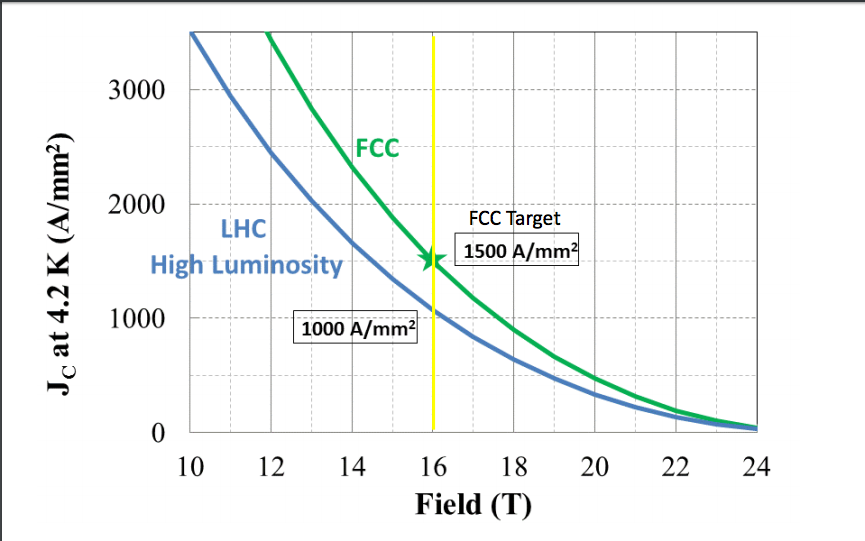![]() FCC paves the way for future superconductors
FCC paves the way for future superconductors
by Panos Charitos (CERN)

Nb3Sn Rutherford cable for high-field magnets to be used in HL-LHC as well as for future colliders covered by the FCC study (Image: CERN)
The FCC Week 2017 offered a unique opportunity to discuss the program and the on-going activities, for the development of Nb3Sn superconductor for the FCC 16T magnets. In a number of dedicated sessions, scientists and industry representatives came together to discuss targets and work on conductor launched for enabling design of compact and cost-efficient magnet design.
In her opening talk, Amalia Ballarino, Head of CERN’s Superconductors & Superconducting devices section, reported on the challenges associated with the development of a Nb3Sn wire that should have performance exceeding that of present state-of-the-art materials. She also reported on the status and progress of the collaboration agreements (Japan, Korea, Russia) launched by CERN and carried-out in the past year. Specific strategic R&D programs have been launched, in parallel with the on-going production for HL-LHC (Europe and USA). Indeed, both performance and quantity of conductor needed for a potential future FCC machine require a world-wide effort. Three talks from Japan, Korea and Russia followed her presentation and reported on the status of the on-going work. Encouraging results were already presented and discussed. Performance increase is one of the key targets of the 16 T conductor development programme. Ballarino emphasized the importance of developing higher critical current density (Jc) at the target field, i.e. the amount of current that goes through the superconducting part of the wire that represents about 50% of the total cross section.
Ballarino emphasized that the focus at this stage is on the development of Nb3Sn multi-filamentary wires meeting the target performance of 1,500 Amperes/mm2 at 16 Tesla and a temperature of 4.2 Kelvin (-268.95 °C). She reported that the cost of the process adopted for the R&D work shall also enable large scale production and achievement of the final target (≤ 5 Euro/kA m) – together with an increased Jc. Presently, the conductor procured from HL-LHC has an average of 1,000 A/mm2, with some samples reaching about 1200 A/mm2, and a fundamental development R&D effort has to be done in order reach the goal for FCC.

Another key aspect for the success of the programme is to involve industrial partners from an early stage. From the current experience from LHC and HL-LHC we know that the performance requirements for Nb3Sn conductor for future circular collider are challenging. A large industrial effort is needed to engage the community on performance and feasibility of a potential very large-scale production (thousands of tons of conductor).
Researches from various laboratories come close with tindustry to study new materials and ways to achieve the required goal. Examples of academic activities include the characterization of materials that take place in laboratories and institutes all progressing in a global fashion.
Finally, Ballarino reported that the conductor programme explores also the potential of other still novel superconductors MgB2 and iron based superconductors are part of the study. Though these materials are not mature today for magnet development, they both show some potential and are therefore worth investigating for future applications. Understanding of present limits of MgB2 at high field and potentials of iron based are being carried out via collaborations launched by CERN with SPIN and Columbus. Marina Putti from University of Genova/SPIN discussed the collaboration agreement with CERN concerning the development and characterization of MgB2, Bi-2212 and iron based superconductors. Moreover, Columbus Superconductors studies the production of MgB2 wire optimized for high fields.
Cost reduction is one of the key challenges that was clearly set from the beginning of this program and lies at the centre of the study for a future circular collider. Further work is needed to understand how this goal can be achieved. Clearly, increase of Jc, large billets size, the optimization of the processcost along with the optimization of raw materials that arekey elements for cost optimization.
In addition to increased performance and reduced costs, the feasibility of large production is a main target for the future. As Ballarino mentioned, the FCC-hh baseline scenario would require about 7000-9000 tons while a High Energy LHC would require about 2500 tons. This poses a significant challenge compared to present project where Nb3Sn production is also important like ITER (about 500 tons) and the amount for the foreseen HL-LHC upgrade (25 tons).
In parallel with the development of the conductor, the procurement of about 290 km of Nb3Sn wire is foreseen, to cover the needs of the magnet program from 2018 to 2019. The program will also require an additional 6 tons from 2020 to 2030. For this wires, the target Jc (4. 2K, 16T) is 1200 A/mm2and a minimum Jc (4.2 K, 16T) equal to 1000 A/mm2.
FCC Conductor development paves the way for the future. Synergies between magnet designers, superconductor experts, material scientists and industry are required to make the next step. The meeting pointed to that direction by bringing together industrial partners and external laboratories and by encouraging collaborations amongst them.
